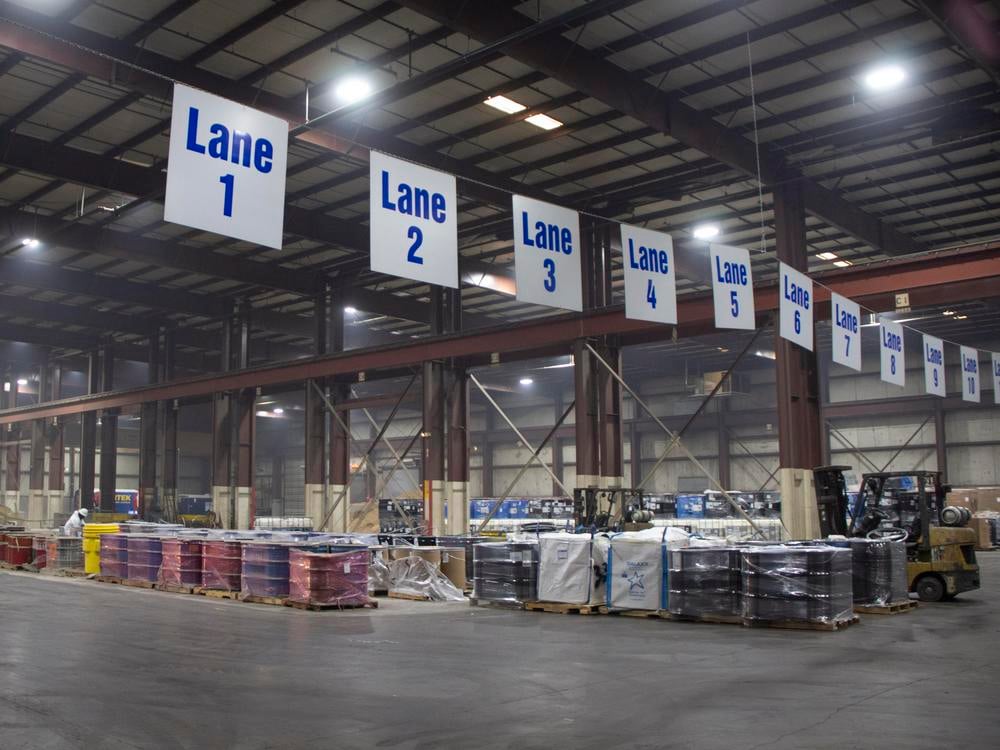Preparing Materials for Delivery
Material Packaging
All materials must be packaged to meet our criteria based on anticipated handling requirements specific to each waste material. Because each facility has different capabilities, handling requirements also vary. The following general guidelines will apply in all but the most unique situations.
Pit Feed
Materials for pit feed can be packaged as follows:
- Boxes, drums and cubic yard boxes made of cardboard, fiber or poly (Wooden crates and aluminum/steel totes can be reviewed on a case-by-case basis)
- Steel drums/containers (accepted on a case by case basis at facilities that do not have a drum shredder)
- Containers should be palletized and shrink-wrapped or banded
- Each movable unit should be limited to a size maneuverable by a standard forklift

Direct Feed
Materials are fed directly for three reasons:
- To ensure our environmental, and health and safety requirements are met
- For secure disposal or witnessed burns
- Operational concerns
Packaging guidelines for direct feed include:
- Boxes and drums should be made from cardboard, fiber or poly (no steel drums, wooden crates or aluminum/steel totes)
- Maximum container weight and package size will vary from plant to plant, Reworld™ approval packages will specify exact size and weight restrictions
- Containers should be palletized and shrink-wrapped
- Each movable unit should be limited to a size maneuverable by a standard forklift
Material Labeling
In general, each movable unit must be labeled. A movable unit may be defined as a:
- Box
- Drum
- Cubic yard box (Gaylord) or bag (super-sack)
- Palletized and shrink-wrapped set of boxes or drums
Labeling must include the following on each movable unit:
- The words "nonhazardous" or "non-RCRA regulated"
- The name of the waste(s) contained within the individual unit, as it appears on the approval package
- The corresponding Reworld™ approval number(s) as well as the applicable state approval number(s)
If the packaging container has any additional markings or labeling from previous use that are not applicable to the waste, you may either:
- Completely cover or remove the markings/labels, or
- Place a label on the containers to be reused stating: "This container is being reused for packaging purposes only. The original label is not representative of the contents of the container."
If you have questions regarding packaging of unique waste streams, please contact your account executive at 800-950-8749.
Pre-Printed Manifests
- General information (client location, address, etc.)
- Transporter information
- Destination facility
- Reworld™ Approval Number

You are responsible for verifying that the following information is complete and accurate:
- Description of the waste
- Total weight of the shipment
- Number of pallets (if applicable)
- Notation of any special handling requirements
- Signature as the waste generator
Shipments must conform to all applicable federal and state regulations, as well as, the conditions specified in the Reworld™ Waste Disposal Agreement and the Approval Letter.
A section is reserved on Certificate of Disposal and the Reworld™ Manifest that serves as a Certificate of Disposal. This section is signed by the destination facility and the completed document is returned to your shipping location or another location indicated by you on the manifest.
Bill of Lading: A transporter typically requires their own Bill of Lading. In this case, the transporter completes their form using the information on the Reworld™ manifest. This is a separate procedure for the benefit of the transporter. If you have any questions regarding manifesting, please contact your account executive at 800-950-8749.
Security Procedures
Commencing with the acceptance of waste at one of our Waste-to-Energy facilities, we guarantee secure disposal. To ensure security during transit, we recommend all deliveries have a coded seal placed on the door of the delivery trailer. Upon request, we will write the seal number on the manifest and/or the 48-Hour Pre-shipment Notification: "The delivery arrived with seal number # intact."
The manifest and/or 48-Hour Pre-shipment Notification will then be signed, dated and returned to the client.
Both the Reworld™ Secure Services Pre-shipment Notification and the Manifest may serve as a Certificate of Disposal and will be returned to the client’s shipping location.
Security Breech Action Plan
- The truck will be placed in a secure location and the facility will contact the account executive, who will then contact the generator for directions on how to proceed. If the generator cannot be reached, then the truck will be sent back.
- We will not unload any materials from the delivery vehicle until clearance has been given directly from your representative.
Note: If a witness is scheduled, we will not break the seal until the witness is present.
Security Protocol for Customer Less-Than-Load Deliveries
(LTL Deliveries are only accepted at Material Processing Facilities)
If two or more customer locations have less than a truckload of material destined for delivery to our facility, the customer may request an LTL pick-up. An LTL pick-up must meet the following criteria:
- Only materials from the customer, its subsidiaries and its subcontractors are eligible for LTL pick-ups.
- Representatives from each location must concur with the LTL delivery arrangements.
- Customer facilities involved in an LTL delivery must discuss and coordinate the security needs and requirements applicable to the secondary loading process.
Security Audits
We encourage our customers to conduct scheduled security audits. All personnel conducting such surveillance will display proper identification, declare their purpose upon arrival at the facility and adhere to all Reworld™ procedures and policies for site visits.
If you have questions regarding security procedures, please contact your account executive at 800-950-8749.
Vehicle Loading and Special Delivery Instructions
All Deliveries
The following guidelines apply to all deliveries to our facilities:
- Materials should be loaded onto the delivery truck at your site in a manner that will facilitate unloading by pallet jack or forklift.
- All pallets and containers should be secured in the delivery truck in a manner that protects their integrity during transit.
- Improperly loaded, shifted or spilled deliveries may require additional handling and associated costs, or they may be rejected.
- Appropriate shrink-wrapping, banding and dunnage should be used to avoid over-the-road problems.
Segregated and Special Handling Deliveries
Certain types of materials may require special handling to ensure safe management and disposal. Special handling requirements are outlined in the Terms and Conditions letter within the individual approval package. It is important to make sure all loads are secure before they are released from your site.
For deliveries that contain materials requiring segregation and/or special handling, please use the following loading procedures:
- Place special handling materials on segregated pallets.
- Properly label special handling materials.
- Verify that all special handling materials are clearly indicated on the delivery manifest. (A portion of the QA/QC review will verify that all paperwork for special handling materials matches.)
- Load special handling materials last so they may be unloaded first.
If you have questions regarding vehicle loading or special deliveries, please contact your account executive at 800-950-8749.